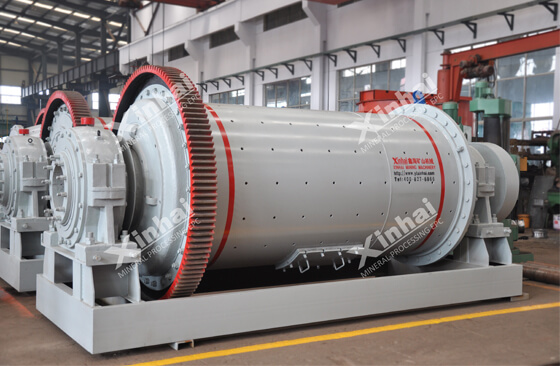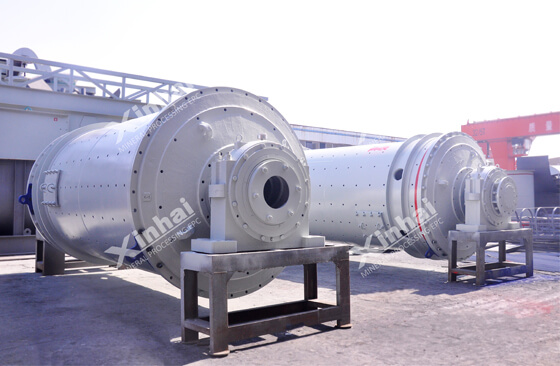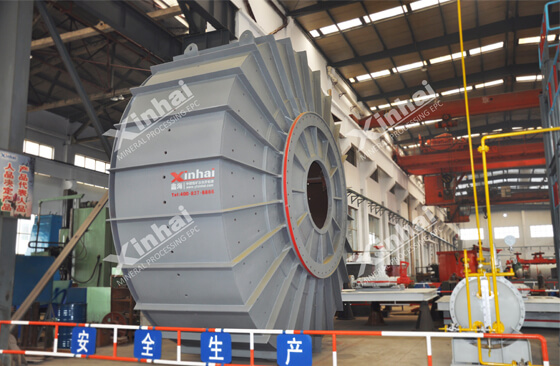

Warm Tip: If you want to know more details about equipment, solutions, etc, please click the button below for free consultation, or leave your requirements!
Grinding machine has been widely used in gold mines in South Africa since 1905. At that time, the grinding machine used river pebble as the grinding medium, which was essentially a gravel mill. Later, in order to improve the production capacity of the mill, cast iron balls were used as the medium, so normal gravel mills were evolved into ball mills and rod mills. This article will introduce the characteristics and selection principles of grinding equipment. Let's get started!
According to structural differences, the ball mills commonly used in concentrators can be divided into two types, grid type ball mill and overflow type ball mill.

Grid ball mill:
The main advantage of the grid ball mill is that the slurry level is relatively low, and qualified products can be discharged in time, which reduces the over-crushing situation of the ore, and the steel ball is less attached to the slurry layer, and the grinding efficiency is high. The grid-type ball mill can load more steel balls, and both large and small balls can be loaded in.
This increases the grinding frequency and makes the unit processing capacity 15-20% higher than that of the overflow type ball mill of the same specification.
The disadvantage is that the structure is complicated, the weight is large, the grid plate is easy to be broken, and the price is high.
According to structural differences, grid ball mills can be divided into two types: short-tube type and long-tube type.
The former is often used for coarse grinding, and the latter is often used for fine grinding. In recent years, new concentrators have tended to adopt the long tube type.
The main difference between overflow ball mill and grid ball mill is that there is no grid plate at the discharge end.
Overflow ball mill:
The advantages of the overflow type ball mill are simple structure, easy management and maintenance, and it has fine product particle size. Due to its large diameter ratio, the product has fewer oversized particles, which creates conditions for the use of high-efficiency classification equipment such as hydrocyclones.
The disadvantage is that the discharge level in the barrel of the ball mill is high, and the slurry stays in the mill for a long time, which leads to material over-grinding and uneven discharge particle size.
The rod mill uses a steel rod as the grinding medium. The steel rod and the ore are in linear contact during the grinding process, which has a certain selective grinding effect. The particle size of the discharged ore product is relatively uniform, and the over-crushed material is small. In rough grinding operations, the production capacity of rod mills is greater than that of ball mills of the same specifications.

The disadvantage is that the rod mill needs to be stopped when adding steel rods. The particle size of the product discharged by the rod mill is generally 3~1mm. When processing some tungsten and tin concentrator gravity separation products, the product size can be less than 0.5mm, but the processing capacity will be much reduced. The particle size of the material fed into the rod mill is generally controlled at 15~25mm.
Even for rod mills with a diameter greater than 2400mm, the maximum feeding particle size of the material should not be too large, because too large feeding particle size can easily destroy the good working condition of the rod mill, which is not good for production.
Due to the large rough grinding processing capacity and high grinding efficiency of the rod mill, in addition to the self-grinding process, the first stage of most two-stage and three-stage grinding operations adopts the open-circuit rough grinding of the rod mill. Rod mills are often used to grind brittle ores such as tungsten and tin, in order to reduce the over-crushing of minerals.

The autogenous mill uses the ore itself as the grinding medium, which saves a lot of grinding balls and avoids product pollution. The feed size is 250~350mm. After one grinding, the product size is between several millimeters and 50μm.
The autogenous mill has a large crushing ratio, which can replace medium and fine crushing operations and the first stage of grinding operations, simplifying the crushing process.
The beneficiation plant of the same scale requires less equipment when using autogenous mill, which can save costs, facilitate centralized management and realize production automation.
The autogenous mill also has a selective grinding effect, and the phenomenon of over-crushing is less. In the grinding process, some steel balls can be added to eliminate "hard-to-grind particles", the so-called semi-self-grinding. The scope of application of the self-mill is limited, and there must be enough ore blocks that can be used as a medium in the ore being ground.
In order to meet the grinding requirements of different materials, there are two types of self-grinding machines: dry AG mill and wet AG mill.
The dry self-grinding machine is suitable for the grinding operation of the dry processing of materials, but it is currently not used much because of the large amount of equipment in the wind classification system, the large dust, and the difficult control of the product size.
The wet AG mill is widely used because of less auxiliary equipment, convenient material transportation, less dust, good working conditions, uniform product size, large processing capacity, and less energy consumption.
The gravel mill uses massive ore, "hard-to-grind gravel" or natural gravel (pebbles) from the sand and gravel field as the grinding medium to reduce steel consumption. Especially for rare metal concentrators, it can prevent iron pollution from grinding products to improve the separation effect. The disadvantage of the gravel mill is its low production capacity.
The particle size of the ore discharged from the gravel mill can reach 90-95% -325 mesh. It generally forms a closed-circuit grinding with a hydrocyclone.
The production capacity of the grinding machine is not only determined by the specifications of the ball mill itself, but also affected by the nature of the ground material and the type of grouped equipment. There is no clear theoretical formula for calculating the processing capacity of the grinding machine. The selection of grinding machine is generally based on grinding experiment and experience.
Firstly, the production capacity of ball mills and rod mills is related to the following factors:
Grindability of ore, feed size and discharge size;
Pulp filling rate, grinding concentration;
The shape, size, matching ratio and physical mechanical properties of the grinding medium, and the medium filling rate of the mill speed;
Model of grinding machine, shape and size of liner;
Type of classifier and its working system, etc.
The processing capacity of ball mills and rod mills is usually calculated by volumetric method or power consumption method, and the selection of ore mill should meet the following requirements:
1) Rod mills are mostly used for rough grinding, with a discharge particle size of 1~3mm, which can be ground to 0.5mm in a gravity separation plant. If the required grinding particle size is too fine, the grinding efficiency will be significantly reduced. Considering the movement of the grinding rod in the mill, the diameter of the grinding machine is generally less than 4500mm, and the length of the grinding rod is generally less than 6000mm. When the rod mill and ball mill are combined, the ratio should be 1:2.
2) The grid-type ball mill is suitable for rough grinding operations and is mostly used for the first stage grinding of the two-stage grinding or single stage grinding. The fineness of closed-circuit grinding products can generally reach 50~70% -0.074mm. Grid ball mills are mostly used in conjunction with spiral classifiers.
3) The overflow type ball mill is mostly used in the second stage or the regrind operation of intermediate products, and is usually combined with a hydrocyclone to form a grinding and classification system. Sometimes the overflow type ball mill is used in the first stage of grinding. At this time, the overflow type ball mill is also equipped with a spiral classifier. Large overflow ball mill (diameter>4000mm) often forms a grinding circuit with a grading cyclone, which is convenient for equipment maintenance and repair.
4) When selecting the AG mill, SAG mill and gravel mill, the tester can be used to measure the ore self-grinding medium index to judge whether there is a good self-grinding medium in the raw ore and decide whether it is necessary to conduct a grinding semi-industrial test . After the test, the empirical formula is used to calculate the selection of grinding equipment.
The above is an introduction to the common grinding equipment and its selection in the concentrator. Grinding is an extremely important operation in the concentrator. The quality of the grinding products directly affects the level of the beneficiation index. It is recommended that you consult with professional beneficiation equipment manufacturers when choosing grinding equipment, and determine the best plan through grinding tests.
If you have different opinions on the above content, or want us to help you choose the right grinding machine, you can contact the online customer service of the website or leave a message, we will contact you as soon as possible!
Last: 3 Commonly Used Zinc Powder Feeders In Cyanidation Plant


What Are the Differences Between CIP and CIL?
 11392
11392
 0
0